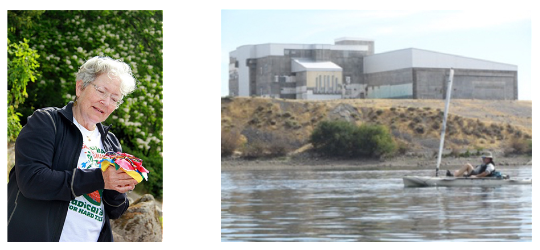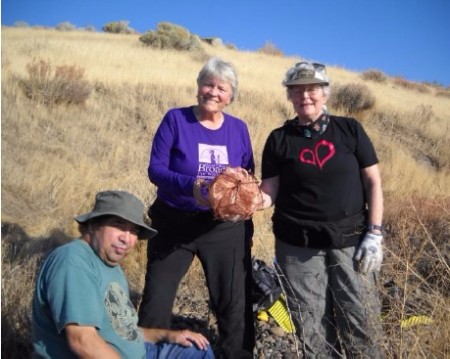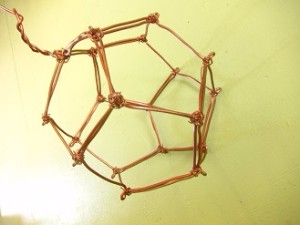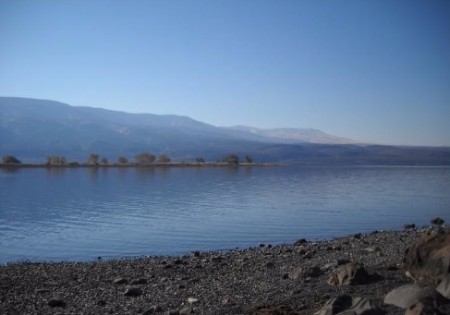Hanford Nuclear Reservation, Oregon
Hanford ETV is Accomplished

For two years, Laura Feldman has diligently stewarded an ETV dedicated to healing the Hanford Nuclear site.
On Oct 28th this vase was finally buried along the shores of the Colombia River in close proximity to the B Reactor.
In 2015 our friend Laura Feldman, requested an ETV for the Hanford Nuclear “reservation” on the Colombia River in Oregon. Over these last few years, she worked with devotion to fill the vase every full moon and took it on pilgrimages all around the region impacted by Hanford, inviting others to join her in meditation and ceremony. On October 28th she and a small group made one last pilgrimage to plant the vase.
In 2015 our friend Laura Feldman, requested an ETV for the Hanford Nuclear “reservation” on the Colombia River in Oregon. Over these last few years, she worked with devotion to fill the vase every full moon and took it on pilgrimages all around the region impacted by Hanford, inviting others to join her in meditation and ceremony. On October 28th she and a small group made one last pilgrimage to plant the vase.
This vase was brought to Laura by another ETV steward, Elizabeth Christine, after she completed the burial of the Canada ETV at the very same time as the ETV was placed at Gabarnmung in Australia – these being the first two of the second generation of ETVs to go out. Laura, who is deeply concerned about the legacy of nuclear waste has been working to raise awareness of the situation at Hanford for years, requested an ETV to assist in this necessary healing which is so difficult to transform. Stewarding the vase, at times Laura felt quite unsure of what to do next but the vase slowly gathered energy and its destiny finally made itself clear. She and three friends traveled to the shores of the Colombia River near Hanford and found the perfect place for the vase’s final resting place. The site is near the “B” reactor which, together with 8 other reactors beside the river, spews poison into the water and unbelievably, will soon be turned into a recreational “theme” park where children play. After the ETV was sealed, it was wrapped in a cloth bag made from the kimono of a Hiroshima survivor. In this, the “overflow” offerings were also placed. This was then wrapped in another cloth from Uganda made from the bark of a tree that is used for burial ceremonies. This was then placed in a hand made container crafted of copper in the shape of a dodecahedron for burial.
Burial of the Hanford Vase
by Laura Feldman

Along the Columbia River one is silenced by the sheer beauty of the landscape;
here, the White Bluffs. Photo: Dan Serres/Columbia Riverkeepers
After stewarding the ETV for two years, on Saturday, October 28th the Earth Treasure Vase and four sleepy earth protectors left Portland at 4am hurtling through the dark to the east side of the Cascades. As the light came up Judy Todd, Cass and Rayvan Martinez and I found ourselves on the vast central Washington plateau, entering the land of the Confederated Tribes of the Yakama Nation. Arriving at the Yakama Cultural Center Museum in Toppenish at 8am we began our entry into the deep story of this land and its first peoples.
As a Hanford activist, I always felt that a deeper spiritual relationship with place needed to be cultivated; I just didn’t really know how. Uneasily, and unsure at first as to how to share the Earth Treasure Vase, I was able to practice community healing rituals with Radical Joy for Hard Times and other gatherings that Judy Todd of Nature Connect NW organized. Slowly, I began to more consciously engage and practice the subtle activism of healing my relationship with the earth while following the vase on its journey to the Hanford Nuclear Site, North America’s most contaminated place.
In recent years I’ve seen the transformation of Hanford into a nuclear theme park showcasing the famous “B” Reactor which made the plutonium for the bomb dropped on Nagasaki. In 2016 it became part of the U.S. National Park Service’s Manhattan Project National Historical Park, hosting evening concerts, tours for local school children and tourists near and far. The story of How We Won the War still fails to include Japanese casualties as part of this changing nuclear narrative or the ongoing harmful effects affecting the surrounding bioregion and downwinder communities as far away as Portland. This narrative, allows us to forget the eternal wastes stored at Hanford and its nuclear weapons legacy.

Laura Feldman, on the Columbia River next to one of the 9 deactivated nuclear reactors.
The ETV is in the yellow bundle in front of her on the kayak.
Photo: Dan Serres/Columbia Riverkeepers
Heading towards the Wanapum Heritage Center above the Hanford Reach, we crossed over the Columbia River at the Vernita Bridge, the planned burial site. We’d taken the vase to this spot when it first arrived on The Healing Journey of the Waters. It didn’t feel like the ideal spot—a boat launch area, very busy during fishing season—but the only accessible one that we knew of. In the past month, however, a growing synergy began to emerge around burying the vase— obstacles disappeared, pieces suddenly fell into place, the absence of doubt. I was finding it much easier to trust that the vase would go where it needed to go. When we got out of the car at the Wanapum Heritage Center I felt an immediate connection with the land.
The Wanapum people are one of the Columbia Basin Tribes directly affected by Hanford. They did not sign the 1855 Treaty ceding the land to the U.S. Government, nor did they move onto the Yakama Reservation. They stayed, while their lives, dependent upon the Columbia, became threatened on all sides. Their numbers dwindled but they persevered. Their poignant story was deeply moving. Leaving the center we all knew—this was the place where the vase would be buried.
We never signed a treaty
We never fought a battle
We have always looked after the land
And the land will always look after us.
We have always been here
And we will always be here.
For the past two years the vase moved through communities up and down the Columbia, from the Pacific Ocean to the Hanford Reach, sharing the vase on river banks, in people’s homes and backyards, in a monastery, at a Hanford hearing, on a kayak through the Hanford Reach, and at the monthly Global Full Moon Meditation calls in my home—collecting place-based medicine. We shared stories, our hopes for the healing of ourselves and the land, and grieving the destruction going on all around us. Sadly, I was unable to get permission or blessings from any of the mid-Columbia Tribal Elders to bury the vase which I’d hoped would also include guidance on where the vase should be buried. Yet…
We were finally drawn to a spot on the Columbia River above the Hanford Nuclear Reservation contained by the Wanapum Basalt and Saddle Mountains, nestled behind a large boulder covered by a serviceberry bush where we asked permission from the ancestors and spirits of this place to bury the vase. I read the beautiful Prayer for Journey up the Columbia River that Elizabeth Christine wrote and to gave me when she’d first brought the vase to Portland, excerpted here:
Let us gather and journey knowing we are on the sacred land and waterways of the Indigenous people of the Columbia River.
Let us enter the subtle realms to find right relationship with the ancestors and guardians of this place.
May we commune with Mother Earth – opening to the magnificent intelligence within all aspects of her creation.
Through our fellowship and ceremony, may we each drop into connection with our indigenous selves, coming to know more fully our place of service in sustaining life.

Rayvan Martinez, Judy Todd and Laura Feldman at ETV burial Photo by Cass Martinez
Here, surrounded by beauty and birdcalls we also heard the sound of explosions further upriver from the U.S. Army’s Yakama Firing Range—the contrasts of this sacred and toxic landscape always evident. The vase container made by my friend Tobias Manthey was a twelve-sided copper dodecahedron, a sacred geometry shape, into which the sealed vase would rest after being inserted into a silk bag made by the artist, Yukiyo Kawano, a third generation Hibakusha (survivor of the atomic bombings of Hiroshima and Nagasaki). The cloth was taken from one of her grandmother’s kimonos and sewn with Yukiyo’s own hair. This bag was placed inside of a sack made of bark cloth from Uganda which some tribes there use for their burial rituals. This sack was then wrapped in copper mesh and inserted into the dodecahedron and placed in the ground with our prayers and final offerings.

The ETV was placed inside this copper dodecahedron
constructed by Tobias Manthey for burial.
Afterwards, straggling up the bank with our shovels and pickaxe we were approached by a fire official who had come to investigate a report of a fire. ‘Had we seen anything?’ he asked. Lagging behind I didn’t hear what Judy told him. I knew I couldn’t have described what I’d seen.

Riverbank where the ETV is buried, about 12 miles upriver
from the Hanford site near the Wanapum Heritage Center.
Tags: second-generation
